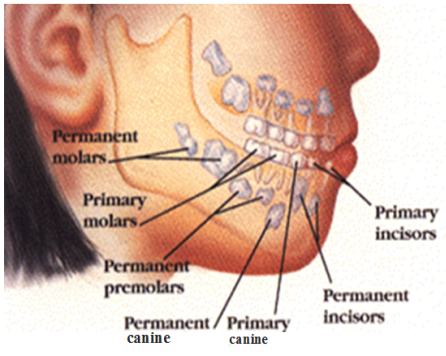
|
Eruption is a complicated process where teeth begin to appear through the gums. Some related facts include:
|
|
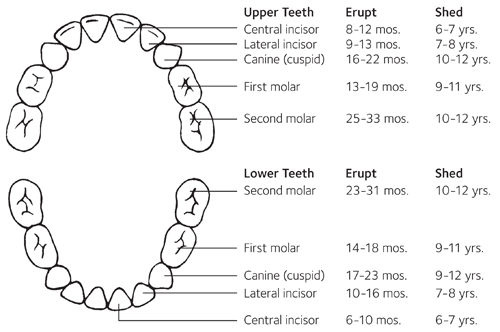
Figure 2 : Tooth eruption chart for the primary dentition. Source from American Dental Association3.
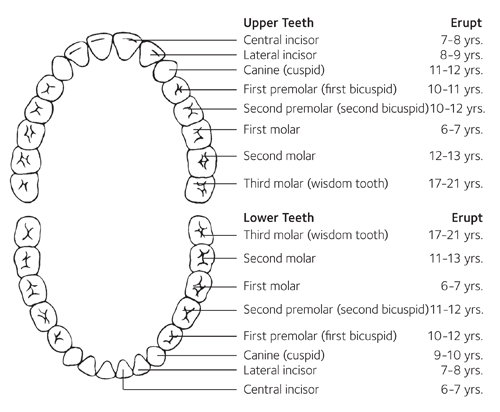
Figure 3 : Tooth eruption chart for the secondary dentition. Source from American Dental Association3.
Most people will have an uneventful teeth eruption. However, some may face issues such as:
-
Delayed eruption
- A delay is when a tooth erupts significantly later than the average population’s eruption time.
- It can also be considered when there is an isolated disruption in the eruption sequence.
- Generalised delayed eruption can be seen in some babies born prematurely, born with low birth weight as well as in malnourished children4. Some children with medical conditions such as Down Syndrome may also present with this condition.
- Conditions such as when there are extra teeth, inadequate space in arch and unusually firm gums can cause localised delay involving a few teeth.
- Early eruption
- Some babies have teeth that erupt early in life, called ‘natal teeth’ and ‘neonatal teeth’.
- They are part of the primary dentition and usually appear at the front part of the lower jaw5.
- Sometimes these teeth will need to be removed, such as when there is risk the teeth will fall off and when they are associated with feeding difficulties.
- Patients with medical condition such as Hyperthyroidism and early puberty can also present with early eruption of teeth.
- Non-eruption due to teeth that are not present
- Missing teeth or hypodontia happens when there is failure in the development of teeth.
- Absence of teeth can range from missing just one tooth to missing all teeth.
- Hypodontia can occur in healthy patients or can be associated in patients with conditions such as cleft.
- Additional teeth
- Some individuals may have extra number of teeth such as supernumerary tooth.
- They can occur in normal people or can be associated with patients having medical conditions.
- A possible consequence to having extra tooth is that it can lead to crowding and delayed eruption.
- Abnormal tooth structure
- Malformed teeth may influence eruption.
- An example is a dilacerated tooth where the roots are formed at a different angle to the axis of the tooth. In severe dilacerations, tooth may not be able to erupt.
- Factors that can cause malformed teeth include trauma or conditions such as the effects of chemotherapy.
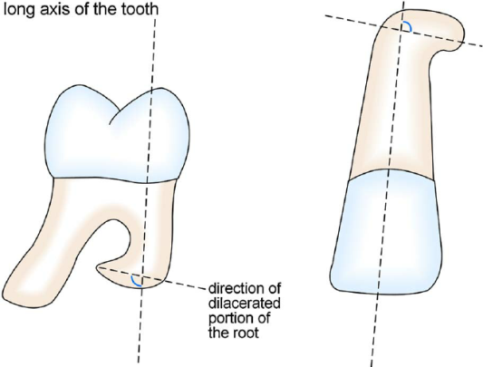
Figure 4 : A illustration of a dilacerated tooth
- Malocclussion
- Generally, it describes teeth that are not well aligned.
- Primary teeth tend to be spaced. However, spacing and crowding of permanent teeth may need thorough consultation by dental professionals.
- ‘Ugly duckling phase’ is a temporary, aesthetically-unpleasant phase when children go through replacement of their front primary teeth.
- Large tooth in a small-sized jaw commonly cause crowding, that can lead to eruption problems.
- Teething
- Teething is the process where teeth sequentially appear by emerging through the gums.
- Some infants exhibit signs of distress such as crying, increased drooling, fever, facial rash, sleep difficulty, mild pain and diarrhoea. Some babies will refuse to eat and drink6-7.
- There is neither universal agreement nor strong scientific evidence to support teething issues6-7.
- Oral pathology
- Eruption cyst is a soft, round swelling that occurs on the soft tissue overlying an erupting tooth. Most will burst spontaneously, needing no treatment.
- Pericoronitis or inflammation of the soft tissues surrounding an erupting tooth can be associated with a wide range of symptoms including severe pain, trismus, swelling and fever.
- Some cysts are related to teeth, such as radicular cyst and dentigerous cyst. Multiple tumours or cysts in the jaws, as seen in some medical conditions might lead to generalized delayed eruption8-9.
To summarise, eruption of teeth can be eventful. In cases with unusual symptoms and eruption patterns, expert consultation would be beneficial.
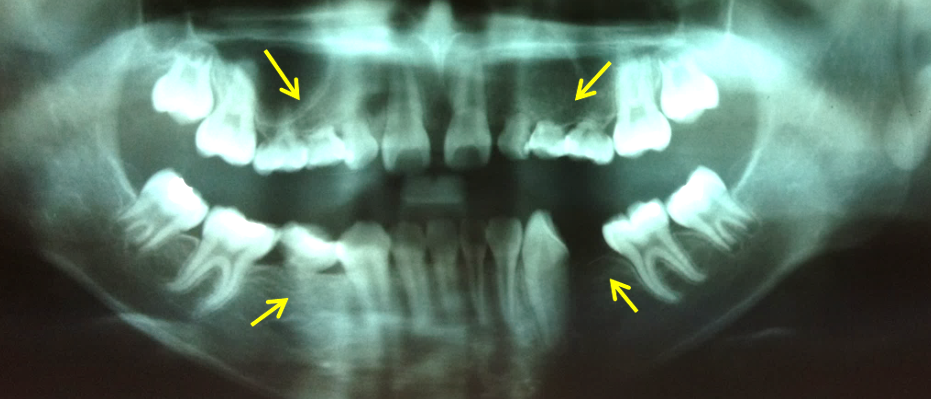
Figure 5 : Radiograph showing a patient with multiple missing permanent teeth.
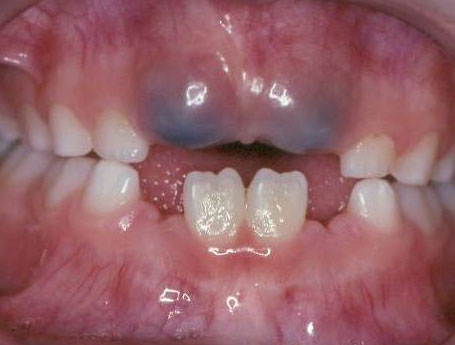
Figure 6 : Eruption cyst filled with blood, sometimes known as eruption hematoma.
References
- Logan WHG, Kronfeld R. Development of the human jaws and surrounding structures from birth to the age of fifteen years. J Am Dent Assoc 1933;20(3):379-427. Adapted by American Dental Association
- Proffit WR, Fields HW. Contemporary orthodontics. 3 rd ed. Mosby Inc.; 2000
- Healthy Mouth by American Dental Association http://www.mouthhealthy.org/en/az-topics/e/eruption-charts
- Harila-Kaera V, Heikkinen T, Alvesalo L. The eruption of permanent incisors and first molars in prematurely born children. Eur J Orthod 2003;25: 293-9
- Cunha RF, Boer FA, Torriani DD, Frossard WT. Natal and neonatal teeth: review of the literature. Pediatr Dent 2001;23: 158-62
- Wake M, Hesketh K , Lucas J. Teething and Tooth Eruption in Infants: A Cohort Study. Pediatrics, 106: 1374–1379, 2000.
- Carpenter JV.The relationship between teething and systemic disturbances. J Dent Child, 45: 381–384, 1978
- Gorlin RJ, Cohen MMJ, Hennekam RCM. Syndromes of the head and neck. New York: Oxford University Press; 2001.
- Buch B, Noffke C, de KS. Gardner’s syndrome – the importance of early diagnosis: a case report and a review. SADJ 2001;56:242-5
| Last Reviewed | : | 13 February 2017 |
| Writer | : | Dr. Suriani bt. Sukeri |
| Accreditor | : | Dr. Bahruddin bin Saripudin |


